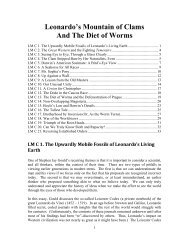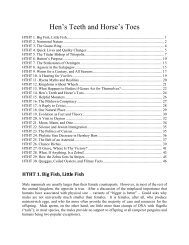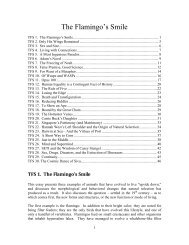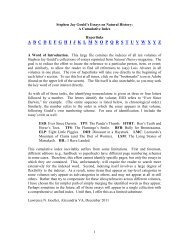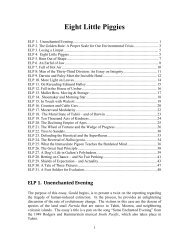half-Jewish meant Jewish, while quarter-Jewish did not; but there were exceptions at bothends.) The rationale behind this is, of course, is one of the Social Darwinistinterpretations of Darwin’s theory of natural selection. Gould came across the exactGerman phrase for “natural selection” while reading the Wannsee protocol, and wasmortified that the most important concept in his intellectual life was explicitly, ifincorrectly, used to justify the Holocaust. He takes the title of the essay from a line inShakespeare’s Julius Caesar, where Mark Antony refers to the stab wound made in theassassinated Caesar’s cloak by his close friend Brutus.While there is no question that the Nazis misused scientific arguments for their own ends,the scientific community cannot be completely absolved, Gould closes. A few scientistsat the time spoke out against this misuse of Darwin’s theory, but most remained silent;some even defended it. William Jennings Bryan, a generation earlier, had certainlyunderstood at a visceral level the attitude behind social Darwinism and eugenics [seeBFB 28; his opposition to the theory of evolution was based on his false belief that theseattitudes were, in fact, Darwin’s theory]. Scientists must remain vigilant against this sortof misuse of science, he states, and be prepared to speak out. However, humility is alsorequired, and scientists must acknowledge that science cannot address moral questions.DIH 25. Can We Complete Darwin’s Revolution?This is one of Gould’s definitive essays regarding his personal philosophy of life, man,evolution, and natural history. He begins with one of his favorite extended quotes fromsomeone other than Charles Darwin. <strong>In</strong> the early 20 th century, Sigmund Freud wrote thatthe most important scientific revolutions were the ones that forced man to confront hislimited importance: “Humanity has . . . had to endure . . . great outrages upon its naïveself-love.” Two such revolutions stood out, in Freud’s view. The first was theCopernican revolution, “when [humanity] realized that our earth was not the center of theuniverse, but only a speck in a world-system of a magnitude hardly conceivable.” Theother was the Darwinian revolution, which “robbed man of his particular privilege ofhaving been specially created, and relegated him to descent from the animal world” – thatis, as he notes in ESD 18, “[evolution] took away our status as paragons created in theimage of God.” (Freud’s motivation for this line of thought was that, Gould notes, hebelieved his own work on the subconscious – undermining views of rational humanthought – would constitute a third such revolution. Freud’s work is not considered to bein this league today, although an accurate predictive theory of consciousness in purelybiochemical terms might well achieve such status. Gould acknowledges that many truescientific revolutions, such as plate tectonics [ESD 20], do not significantly impact ourviews of man’s place in nature, but suggests elsewhere that the discovery of “deep time”[HTHT 6] probably does.)However, Gould’s thesis is that there is a major step between the recognition of therevolutionary premise (a heliocentric solar system, an evolutionary origin of man) and theacceptance of its implications for the reduced status of man, in our own eyes. He refersto this intellectual demotion of humans as “pedestal smashing,” and attempts to resist theimplications – not the premises themselves – as “spin doctoring.” The Copernican/30
Galilean revolution, he argues, is complete in Freud’s sense. It began when peopleaccepted that the earth was not the center of the universe; it was completed when peoplecame to accept the implication that there is apparently nothing particularly unique aboutit. Most people today are comfortable with the concept that life, perhaps even intelligentlife, may exist elsewhere. On the other hand (he continues), Darwin’s theory is notcomplete in this sense. Many people who understand and accept the premise of evolutionas fact do not accept the pedestal-smashing implications that man is just another animal,albeit one with a large brain and unusual cognitive abilities. (He explicitly excludescreationists here. His argument involves the step between accepting “descent withmodification” and of accepting the implications that man is not the end result of either adivine or secular process.) Gould summarizes his view of how we would all viewourselves in a post-Darwinian world without spin doctoring, and its significance to him:I like to summarize what I regard as the pedestal-smashing messages of Darwin’srevolution in the following statement, which might be chanted several times aday, like a Hare Krishna mantra, to encourage penetration into the soul: Humansare not the end result of predictable evolutionary progress, but rather a fortuitouscosmic afterthought, a tiny little twig on the enormously arborescent bush of life,which, if replanted from seed, would almost surely not grow this twig again, orperhaps any twig with any property that we would care to call consciousness.To support his argument that Darwin’s revolution is not complete, and to illustrate somecommon misunderstandings, he turns to his personal choice for “a canonical mediasource for identifying the pulse of an educated culture”: The New York Times. He callsout three items published in the previous twelve months in the “Science Times” section(two of which are letters to the editor). The first draws on the view that evolution worksto benefit species as a whole, which would in turn imply the existence of a higher-levelcontrolling force or principle. Specifically, a reader argues that sexual reproductionevolved because it offers significant advantages to species that employ it. Goulddisagrees:Natural selection may lead to benefits for species, but these ‘higher’ advantagescan only arise as sequelae or side consequences of natural selection’s causalmechanism: differential reproductive success of individuals. . . . Warm and fuzzyideas about direct action for the good of species represent a classical strategy inspin doctoring, one that has precluded proper understanding of natural selectionfor more than a century. . . . Darwin’s mechanism works through the differentialreproductive success of individuals who, by fortuitous possession of featuresrendering them more successful in changing local environments, leave moresurviving offspring. Benefits accrue thereby to species in the same paradoxicaland indirect sense that Adam Smith’s economic theory of laissez faire may lead toan ordered economy by freeing individuals to struggle for personal profit alone –no accident in overlap, because Darwin partly derived his theory of naturalselection as a creative intellectual transfer from Smith’s ideas.31
- Page 4 and 5: cloud (“nebula”) of gas and dus
- Page 6 and 7: goodness, and is both intelligent a
- Page 9: The second news story involves the
- Page 12 and 13: key ways. Prior to 1994, no fossil
- Page 14: DIH 11. Lucy on the Earth in Stasis
- Page 17: directly resulted in a mass extinct
- Page 20 and 21: Edgar Allan Poe, it turns out, wrot
- Page 22 and 23: things male, while the beautiful is
- Page 24 and 25: interest, until the entrepreneur of
- Page 26 and 27: essay is that scientists, for all t
- Page 28 and 29: DIH 23. The Smoking Gun of Eugenics
- Page 32 and 33: Darwin’s theory, like Adam Smith
- Page 34 and 35: What might a better definition of t
- Page 36 and 37: type of soil, amount of rain, and s
- Page 38 and 39: Case Four, in Gould’s words, is
- Page 40 and 41: multiplying his findings by the num
- Page 42 and 43: other departments, something that r
- Page 44 and 45: Linnaeus, Gould states, did not sim
- Page 46: greatly prefers these metaphors, on




